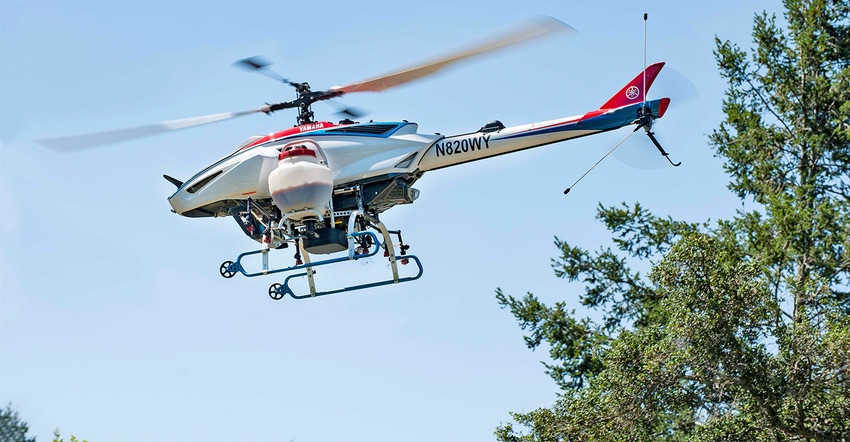July 16, 2018

Rising interest in unmanned aerial vehicles is driving new business in agriculture. As the tech improves for gathering information, farmers are finding new uses for these tools. But there’s one bridge yet to cross — using such an airship to do more than take detailed pictures. Yamaha is filling that gap, with its current work in California wine country, and this work shows what could someday be possible.
The FAA granted Yamaha authority to fly its RMAX UAV for commercial use in the United States in 2015. The RMAX was a second-generation airship building on the R-50 the company deployed for use in spraying rice fields in Japan. But there’s a growing opportunity in the United States, and the company announced launch of the Fazer airship recently. “The Fazer is a third-generation platform building on the R-50 and RMAX,” says Brad Anderson, Yamaha Motor U.S. division manager, unmanned systems.
In Japan, farmers deploy these helicopter machines to spray. In the United States, Anderson explains that the company is doing something different. “We’ve initially entered the U.S. market with spray services in Northern California,” he says. “Instead of selling equipment, we’re selling the service.”
The company employs a two- to three-person team that operates the machine. Under the special permit from the U.S. Federal Aviation Administration, the operator must maintain line-of-sight during flight. “We have a minimum of two people involved in the operations on the ground during a flight,” Anderson says.
Right now, the Napa Valley grape-growing region in California is where the service is at work. Yamaha is working with vineyard management companies to fill specific spraying needs through the season.
Anderson notes that right now, the RMAX and Fazer are being put to use for one task — application. “We’re not doing anything advanced, technology-wise,” he explains, “but we are providing a very specific and beneficial service in Napa that vineyard owners and management companies are beginning to appreciate.”
A look at Fazer
The Fazer builds on the RMAX with a new four-stroke engine (the RMAX had a two-stroke power plant). That 390 cc engine allows for a 50% increase in payload. The new machine can hit the sky with 6.3 gallons of material to spray.
“Dimensionally, the machine is the same size as its predecessor,” Anderson says. “With the new engine and some other modifications, we get that payload increase.”
While the current RMAX and Fazer are limited to a Yamaha employee flying the machines, the company is looking at getting a certification for a new Fazer-R machine that would allow service firms to lease the airship for use. The Fazer-R would have an even higher payload capacity, more than 8 gallons.
“There’s a strong amount of curiosity out there about these machines,” Anderson says. “A big part of what we’re doing in Napa is replacing hand spraying with a backpack sprayer.”
Turning that in-season spraying chore over to a drone has value, given the terrain where these vineyards are located. Anderson says that heavy terrain takes its toll on employees for vineyards.
There are other potential markets for this machine, including orchards and vineyards in other states. As Yamaha works toward a type certificate with the FAA, it will allow qualified operators to have an opportunity to use the aircraft. Yamaha would also be expanding its services to include training for the new machines, too.
As for row crop use? These machines aren’t inexpensive, and the volumes of material applied in corn and soybean country would far outstrip what the machines could carry. However, as aerial imagery gets more precise, and diagnosing spot problems in a field gets better, the Yamaha application system may have some value. “It might be possible to use the machine for specific spot spraying in fields,” he says. “You could target a specific area and limit what you apply on the field.”
However, getting that FAA certification for the new Fazer-R isn’t an overnight task. Anderson estimates that it would be one to two years before that machine might get certified on the federal level. “We are slowly adding to the area we cover with our service,” he says. “We’re spraying fields every two weeks in the Napa area.”
Not an easy task
While Yamaha airships have been deployed in Japan for more than two decades, bringing the service here wasn’t just about getting certified. “Napa terrain is different than Japan’s,” Anderson notes. “There are steep hillsides and smaller fields. It’s been a learning curve. We’re fine-tuning the operation and services we offer now.”
While it may be sometime before an application-ready machine is flying over your cornfield, understanding the many ways drone tech is advancing remains important. You can learn more about the Yamaha airship at the Yamaha Motorsports Precision Agriculture webpage. Below, you can watch a video of the work in Napa, Calif., to get an idea of how this machine is being deployed.
About the Author(s)
You May Also Like






